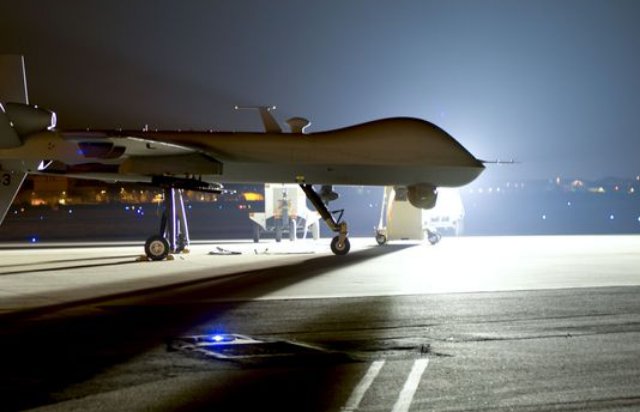Missions for the Army and Air Force are unique enough that the services will likely need to fly their own separate unmanned platforms for the foreseeable future, according to service leaders.
“I think the similarities and the cross talk is going to continue but we kind of have different mission sets, so we can design systems for those mission sets,” Gen. Herbert “Hawk” Carlisle, the head of Air Combat Command, told Air Force Times. “Right now I don’t see them overlapping near as much as Navy, Air Force, and Marines all flying the F-35. I don’t see that same overlap.”
Carlisle spoke to reporters following a Senate Armed Services Subcommittee on Airland hearing where lawmakers asked the same question, wondering whether the two services should be working more closely together on their remotely piloted aircraft programs, including the Army’s MQ-1C Gray Eagle and the Air Force’s MQ-9 Reaper.
When asked by Sen. Joe Manchin, W.Va., the top Democrat on the subcommittee, whether the Air Force and Army were using the same equipment, Carlisle responded that “theMQ-1C Gray Eagle and the MQ-9 [Reaper] are totally different systems.”
“The training, the tactics, techniques and procedures, doctrine, would be similar but the actual training on the system, between the MQ-9 and the MQ-1C are significantly different,” he said.
The general said the Army’s Gray Eagle is much closer in operation to the Air Force MQ-1 Predator, but the latter system is set to start retiring in 2016 and 2017 after nearly 20 years in service.
Army Gen. David Perkins, the head of Army’s Training and Doctrine Command, said that while soldiers who fly unmanned aerial systems (UAS) receive training and Federal Aviation Administration certification, most are not trained pilots.
“There’s a significant difference in the technology in how [Air Force RPAs are] operated,” he told the committee. “Ours are: it is point and click from the ground station. It is not a stick and rudder. They are not flying them, and they’re automatic take off and landings. Those are very difficult skill sets to train somebody with. Ours is different from that point of view…Our unmanned aerial systems are really operated by our sergeants, soldiers and warrant officers. They’re doing a great job but the actual physical activity is significantly different.”
Many of the senators’ questions were prompted by a report from the Government Accountability Office that recommended the services work more closely together on training unmanned pilots.
“The size, sophistication, and cost of DoD’s UAS portfolio has grown considerably, as has the demand for trained pilots,” Brenda Farrell, the director of Defense Capabilities and Management at the GAO, told the committee.
“Coordinated training between the services could help shorten the amount of time the services spend acclimating to each other once deployed and would allow an easier transition when working together during missions,” she said. “However, we found that no DoD-wide training strategies existed, and we recommended that DoD issue a department wide UAS training strategy that addresses if and how the services should coordinate with one another to share information on training of UAS pilots.”
“Without such a strategy, the services will not be positioned to capitalize on training opportunities and may waste scarce resources,” Farrell continued.
Carlisle said the services are finding ways to work together, such as a number of Marines taking basic Air Force RPA training. But the requirements for the services are often very different.
Army unmanned platforms are attached to and controlled by a battalion or division to support those soldiers, while “from an Air Force perspective, it is a theater asset doing theater-level airpower,” he said.
“[The pilot] could do close air support, he could do solely [intelligence, surveillance, and reconnaissance], he could do strike, he could do personnel recovery, he can do interdiction, he can do interdiction of targets in the deep fight,” Carlisle said. “The missions that our RPAs fly, it’s a theater-level asset given to the joint force commander for his allocation to meet the theater-level missions that he’s trying to do.”
Meanwhile, Sen. Tom Cotton, R-Ark., the subcommittee chairmen, made it clear he believes unmanned pilots deserve more admiration.
“Maybe our society should pay them the respect they deserve and honor their service, without attaching stigma to what they do, since they are keeping us safe in our beds at night,” he said.
Photo: Staff Sgt. John Bainter/Air Force
Source: Air Force Times

